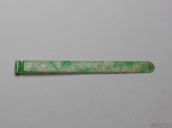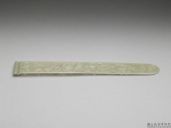From yizitou to liangbatou
If someone were to travel back in time to Qing China and see a Manchurian woman for the first time, they would surely be surprised by her hairstyle. The Manchurian female coiffure was a sight to behold, especially in the beginning of the 20th century. At that time the liangbatou 兩把頭, as this hairstyle was named, had become the hairstyle typically associated with Manchu women. The liangbatou was named after its resemblance to two hands of hair on the side of the head. Where did this extravagant hairstyle, as shown by the Barbie exhibited here, come from?
In the first half of the 17th century, the Manchus came riding into China on horseback. The Manchurian troops were easily recognizable by their slim tail at the back of their otherwise bald head. As time went by, the Manchurian women also came to settle in the newly captured territory that would become the Qing dynasty (1636-1912). At this time, earlier forms of the liangbatou existed and were worn by Manchu women, and perhaps the differences between the hairstyles represented differences of status in the Banner system of the Manchus.[Cf, p 178] For foreigners coming to China, any woman boasting a liangbatou-esque hairstyle was certainly Manchu:
While saying my greeting, I quickly looked her up and down. The woman had a lot of flowers in her hair as well as a gold hairpin. Her cheeks were rouged and she wore jade ear-rings. Her black trousers had many silver buttons stitched closely together and she wore embroidered shoes with a pattern of grass, flower, bee and butterfly. I thought she might be a Manchurian woman because her legs were not wrapped with bindings and she was not wearing shoes appropriate for bound feet.[Cf, p 49]
In the late 18th century, the Korean scholar Bak Jiwon travelled through Manchuria to Peking to attend the 70th birthday celebration of the Qianlong emperor (1711-1799). The Manchurian women that Bai Jiwon describes may not have worn a liangbatou yet at this time, but the headdress most likely already had taken on its recognizable, widespread shape. Most likely, the haircut would have been named the yizitou 一字头. This name also describes the flat and wide hairstyle, using the Chinese character yi 一 due to the character being just a wide line.[Cf, p 177-8])
The shape of this hairstyle, as with the liangbatou, was upheld by a device called bianfang 扁方.The bianfang was a flat strip of wood, or other materials, that was put underneath the hair. The hair was then wrapped around this small frame. The frames in the Qing court were, of course, made of exquisite materials, and would be decorated with characters that, for instance, represented longevity. This bianfang would stick out at the back of the head. In the beginning, the bianfang was very important for keeping the hairstyle together, but as time went by, the bianfang was used more for decorative purposes, as we shall see in the next markers.






